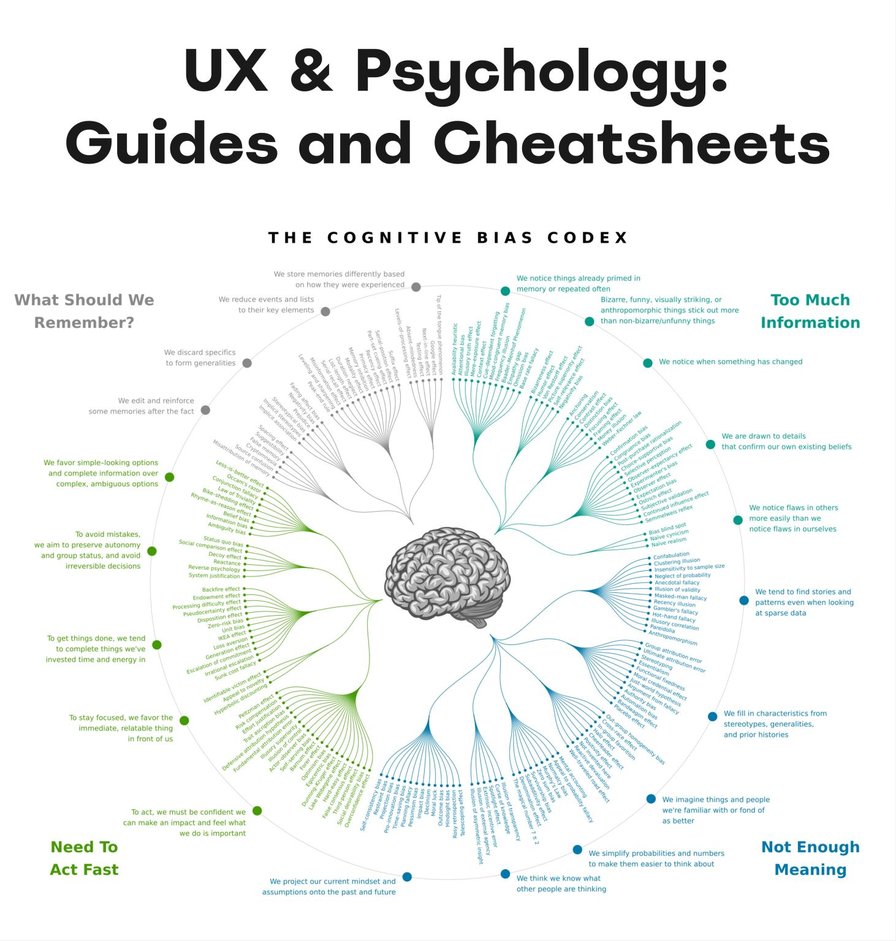UX & Psychology

my notes ( ? )
🤔 We think we know what others are thinking (we don’t!).
🤔 Too often we fill in gaps and detail from stereotypes.
🤔 We project our assumptions onto the past and future.
🤔 We tend to avoid or postpone irreversible decisions.
🤔 We edit and reinforce some memories after the fact.
🤔 We don’t see everything and we overlook details.
🤔 We simplify probability and numbers to make sense.
🤔 We are drawn to details that confirm our own beliefs.
🤔 We tend to believe things we choose to believe.
🤔 We transfer our experiences on other people.
As GK VanPatter noted, what is often missing in conversations on cognitive biases are divergent thinking bias and convergent thinking bias, with the latter being by far the most prevalent.
With the divergent thinking bias, we often generate too many ideas without properly evaluating their quality of feasibility. As a result, we at times resist making decisions and narrow down solutions, and hence often overlook obvious solutions. I definitely fall into that trap frequently — and then get lost in all the fine details, without a clear path forward.
With the convergent thinking bias, we rely too much on logical analysis while totally ignoring emotional factors, and then fall prey to confirmation bias when evaluating solutions. So we rush towards a single right answer, and often skip or ignore the option of experimentation.
Both of these biases can be very counterproductive when we try to innovate and find solutions to a given problem. They are often overlooked and forgotten — so watch out for them, and flag them for yourself and for your team when designing the next big thing.
---
💎 Useful resources:
Psychology Insights Cookbook, by Jerome Ribot 👍🏽
Docs: https://lnkd.in/epGNUd9j
Figma: https://lnkd.in/gHEU4R9Y
Laws of UX, by Jon Yablonski 👍🏽
https://lawsofux.com/
Psychology UX Glossary, by Peter Ramsey 👍🏽
https://lnkd.in/ek9Pi-CG
Cognitive Bias Cheat Sheet, by Buster Benson
https://lnkd.in/eCGDp4mP
Psychological Principles And How To Apply Them (Figjam), by Maryna Kucherova 🇺🇦, via Paweł Huryn 🇺🇦
https://lnkd.in/eQE2y5HG
The Psychology of Design, by Dan Benoni, Louis-Xavier Lavallée
https://lnkd.in/d5Z6TpVt
Cognitive Biases Explained, by Krisztina Szerovay
https://lnkd.in/eCxbBBS9
Behavioral Science Insights (Miro board), by Elina Halonen
https://lnkd.in/eW5XgwDk
The Big Behavioral Bias (Miro Board), by Robert Meza
https://lnkd.in/ei-Xs-tD
Behavioral Evidence Hubs 👍🏽
https://www.bhub.org/
https://www.besci.org/
Read the Full Post
The above notes were curated from the full post www.linkedin.com/posts/vitalyfriedman_ux-design-psychology-activity-7256257032964468737-SuZq?utm_source=share&utm_medium=member_desktop.Related reading
More Stuff I Like
More Stuff tagged guides , psychology and ux
See also: UX study guides & guidelines